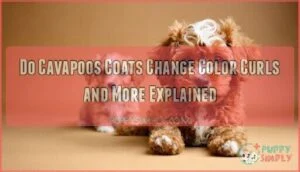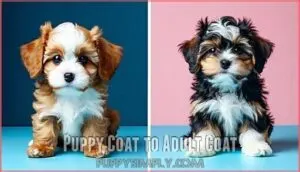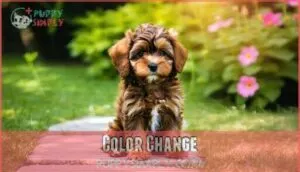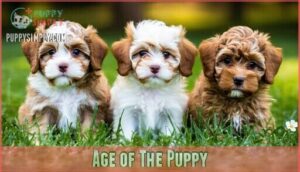This site is supported by our readers. We may earn a commission, at no cost to you, if you purchase through links.
 Yes, your Cavapoo’s coat will change substantially. Most Cavapoos experience dramatic transformations in both color and texture between 6-14 months as their puppy fur evolves to adult coat. Colors often fade – reds lighten to cream, blacks develop silver tones, and chocolates become café au lait shades.
Yes, your Cavapoo’s coat will change substantially. Most Cavapoos experience dramatic transformations in both color and texture between 6-14 months as their puppy fur evolves to adult coat. Colors often fade – reds lighten to cream, blacks develop silver tones, and chocolates become café au lait shades.
The texture typically becomes curlier or wavier than the soft puppy fur. These changes stem from inherited Poodle and Cavalier genes, with the D locus causing color dilution and the G locus triggering progressive greying. Full stabilization occurs around 2-3 years of age.
The transformation affects all three coat types – hair, fleece, and wool – though each requires different grooming approaches as the adult texture develops. The changes are due to the inherited genes, specifically the interaction of the D locus and G locus, which influence the final coat color and texture.
Table Of Contents
- Key Takeaways
- Types of Cavapoo Coats
- Cavapoo Coat Changes
- Factors Affecting Coat Color Change
- Managing Coat Changes
- Frequently Asked Questions (FAQs)
- Do cavapoos change color?
- Do cavapoos get darker?
- Do cavapoos have a curly coat?
- How do I choose a Cavapoo color?
- Are Cavapoo puppies the same color?
- How long does it take for a Cavapoo’s coat to change color?
- What factors affect the amount of coat lightening that occurs?
- What is the best way to manage coat changes?
- What are the rarest Cavapoo colors?
- What are the best Cavapoo colors?
- Conclusion
Key Takeaways
- Your Cavapoo’s coat will dramatically transform – expect substantial changes in both color and texture between 6-14 months as puppy fur evolves to an adult coat, with full stabilization occurring around 2-3 years of age.
- Color fading is completely normal – reds lighten to cream, blacks develop silver tones, and chocolates become café au lait shades due to inherited Poodle genes, specifically the D locus and G locus affecting pigmentation.
- Three distinct coat types require different care – hair coats are low-maintenance and straight to wavy, fleece coats need daily brushing to prevent tangles, and wool coats are the most hypoallergenic but require professional grooming every 4-6 weeks.
- Daily grooming prevents problems during transitions – regular brushing with proper tools prevents matting and maintains coat health throughout the 2-3 year development period when your pup’s texture becomes curlier and denser.
Types of Cavapoo Coats
You’ll find three distinct coat types in Cavapoos, each with unique characteristics that affect appearance and maintenance needs.
Understanding these coat variations helps you prepare for your dog’s grooming requirements and predict how their appearance might change over time, which is related to their grooming requirements.
Hair
A Cavapoo’s hair coat offers the perfect middle ground between maintenance and manageability. This coat type features straight to slightly wavy strands that won’t curl tightly like other Cavapoo coat types. You’ll find hair coats easier to brush through, though daily grooming prevents matting as your pup matures from puppy fluff to adult density.
Hair coats are naturally low shedding, making them ideal for families concerned about coat shedding around the home. The hair texture remains soft yet structured, giving your Cavapoo that classic teddy bear appearance without excessive grooming demands.
Key characteristics of hair coats include:
- Straight or gently waved hair growth patterns
- Minimal coat shedding compared to traditional dog breeds
- Softer hair texture that’s pleasant to touch
- Simple hair care routine with regular brushing
- Gradual coat color changes as they mature
As your Cavapoo matures, expect coat changes in both texture and hue, with most color shifts stabilizing by age two. Regular use of proper grooming tools helps maintain a healthy coat.
Fleece
What makes fleece different from other Cavapoo coat types? This popular fleece texture strikes the perfect balance between curly patterns and manageable maintenance.
Your fleece coat Cavapoo sheds moderately but requires regular brushing for tangle prevention. As coat color changes occur during puppyhood, fleece maintenance becomes essential. Daily grooming prevents matting while preserving the soft, wavy appearance that makes fleece coats so desirable among Cavapoo coat types.
Wool
What makes wool coats so distinctive among Cavapoo coat types? Wool coats boast the densest and most hypoallergenic benefits, featuring tightly packed curly patterns that create exceptional coat density. This luxurious wool texture resembles sheep’s fleece more than typical dog fur.
Your Cavapoo’s wool coat requires dedicated grooming tips including daily brushing and professional sessions every 4-6 weeks to prevent matting. Unlike fleece coats, wool maintains its structure through coat color changes, though the Poodle genetics still influence fading over time. Understanding cavapoo coat care is essential for maintaining the health and appearance of your Cavapoo’s wool coat.
Cavapoo Coat Changes
You’ll witness fascinating transformations as your Cavapoo grows from puppy to adult. These changes affect both color and texture, creating a completely different-looking dog by maturity.
Puppy Coat to Adult Coat
Your Cavapoo’s transformation begins around 6-14 months when their soft puppy coat gradually changes to a denser adult coat. This coat change takes up to two years, shifting from fine, fluffy fur to thicker, potentially curlier adult texture that requires more maintenance.
From fluffy puppy fur to dense adult curls – your Cavapoo’s coat journey is a two-year transformation worth embracing
- Puppy Development Timeline: Adult coat maturity completes between 12-24 months, with increased shedding and matting prevention needs during this period. Understanding the cavapoo shedding patterns is vital for effective grooming and care.
Color Change
Transformation begins gradually – your Cavapoo’s coat color changes start around six months, reaching completion by two to three years. This pigmentation shift stems from genetic influence inherited from Poodle parents.
Color fading patterns vary dramatically: reds lighten to apricot, blacks turn silver-gray, and chocolates fade to café shades. Coat lightening depends entirely on your puppy’s inherited fading genes, making color prediction challenging but fascinating.
Understanding the rare color genetics can help you appreciate the unique characteristics of your Cavapoo’s coat color changes.
Factors Affecting Coat Color Change
You’ll notice your Cavapoo’s coat changes aren’t random – specific factors drive these transformations. Understanding what influences these shifts helps you prepare for your pup’s evolving appearance.
Inherited Genes
Genetic variation creates your Cavapoo’s unique coat transformation. Your pup inherits specific genes from both Poodle and Cavalier parents that determine adult coloring.
Your pup’s coat color destiny lies in their DNA – a genetic lottery from Poodle and Cavalier King Charles Spaniel parents
Key inheritance patterns include:
- D Locus gene – causes dramatic color dilution in darker coats
- G Locus gene – triggers progressive "greying" throughout life
- Poodle fading gene – lightens reds and chocolates to cream tones
- Cavalier genetics – helps maintain original puppy colors longer
DNA testing reveals which genes your Cavapoo carries, helping predict whether they’ll keep their current shade or fade substantially by adulthood. Understanding color genetics basics is essential for anticipating potential coat color changes in your Cavapoo.
Age of The Puppy
As your Cavapoo puppy develops, their coat undergoes dramatic transformations. Puppy development typically triggers coat color changes around six months, when soft puppy fur begins changing to adult texture.
Growth stages reveal the most pronounced shifts between 6-12 months, with the maturity timeline extending up to three years for complete color stability. Your Cavapoo puppy’s age directly influences when and how extensively their coat will change.
Understanding the genetic factors of color change processes can help you better anticipate your Cavapoo’s coat development.
Managing Coat Changes
You’ll need to stay on top of grooming and maintenance as your Cavapoo’s coat transforms from puppy fluff to adult texture.
Regular brushing and proper care will help you manage color changes and prevent matting during this development period.
Regular Grooming
Understanding your Cavapoo’s grooming needs prevents coat problems before they start. You’ll want to establish a routine that addresses the breed’s unique requirements and coat phases.
- Brushing Techniques: Use a slicker brush daily to prevent matting and control shedding during coat changes
- Nail Care: Trim nails every 2-3 weeks to maintain proper paw health and comfort
- Ear Cleaning: Clean ears weekly with gentle solution to prevent wax buildup and infections
- Shedding Control: Regular brushing removes loose hair and reduces household cleanup needs
Regular grooming involves understanding cavapoo coat care to maintain a healthy coat.
Maintaining a Healthy Coat
Everyone wants their Cavapoo’s coat to stay healthy as color and texture changes occur naturally. Proper Cavapoo coat maintenance starts with coat nutrition – feeding diets containing 18-22% protein and omega fatty acids supports skin health and coat shine. Daily brushing prevents matting prevention while distributing natural oils for glossy fur. Use quality grooming tools designed for curly coats. Bathe every 4-6 weeks to avoid stripping natural oils that cause dryness.
Shedding control improves during coat transitions with consistent Cavapoo grooming routines:
- Monitor skin health for irritation or hot spots that damage coat integrity
- Supplement with omega-3 fatty acids and biotin for enhanced coat softness
Professional dog coat care every 6-8 weeks maintains prime coat condition throughout coat color changes. Investing in the right Cavapoo grooming tools is essential for a healthy coat.
Frequently Asked Questions (FAQs)
Do cavapoos change color?
Yes, Cavapoos do change color. Color changes typically start around 6 months and complete by 2-3 years due to the Poodle’s fading gene, with darker colors more prone to lightening than lighter ones.
Do cavapoos get darker?
Cavapoos can get darker, though lightening is more common.
Your pup’s coat color depends on genetics – some darken while others fade.
The change typically starts around 6 months and completes by 2-3 years.
Do cavapoos have a curly coat?
Cavapoos don’t always have curly coats. Their coat texture depends on genetic inheritance from both Poodle and Cavalier King Charles Spaniel parents, resulting in hair, wool, or fleece variations with different curl patterns.
How do I choose a Cavapoo color?
Like picking the perfect paint for your canvas, choosing a Cavapoo’s color requires understanding genetics will likely fade darker hues over time. Consider your lifestyle, grooming commitment, and remember puppy colors often change substantially by adulthood.
Are Cavapoo puppies the same color?
No, Cavapoo puppies aren’t the same color. Each pup’s genetics create unique combinations from their Poodle and Cavalier parents, resulting in different coat colors and patterns even within the same litter.
How long does it take for a Cavapoo’s coat to change color?
Picture your Cavapoo’s coat as a canvas slowly revealing its true colors.
Color changes begin around six months and stabilize by two to three years of age, depending on inherited Poodle genetics that cause fading.
What factors affect the amount of coat lightening that occurs?
Several key factors determine how much your Cavapoo’s coat will lighten over time. Genetics play the biggest role—inherited genes from the Poodle parent, especially the fading gene, strongly influence lightening extent and whether it occurs at all.
What is the best way to manage coat changes?
Daily brushing prevents matting during the 2-3 year coat development period. You’ll need professional grooming every 4-8 weeks, especially for wool coats that require extensive maintenance and care.
What are the rarest Cavapoo colors?
The rarest Cavapoo colors you’ll find are chocolate, merle, black, and tri-color combinations. These unique shades occur less frequently due to specific genetic combinations from both parent breeds, making them highly sought-after.
What are the best Cavapoo colors?
The best Cavapoo colors are red, chestnut, and ruby, which offer the most aesthetic appeal. These warmer tones tend to be less prone to fading than darker colors like black.
Conclusion
Clearly comprehending Cavapoo coat changes helps you prepare for your pup’s transformation journey. Understanding that do cavapoos coats change color curls and more is completely normal allows you to embrace these natural developments rather than worry about them.
Your Cavapoo’s evolving appearance reflects their genetic heritage from both parent breeds. Regular grooming and proper care will help maintain their coat’s health throughout these changes, ensuring your furry companion looks and feels their best regardless of their final color or texture, which is a result of their natural developments and overall health throughout these changes.
- https://allgroom.co.nz/blogs/breed-guides/oodle-puppy-adult-coat-change
- https://www.reddit.com/r/CavaPoo/comments/t7g711/scraggle_mess_at_5_months_will_it_change/
- https://www.mydoodlepuppy.com/cavapoo-grooming
- https://premierpups.com/blogs/cavapoo-shedding
- https://www.ilovemycockapoo.com/threads/can-you-tell-coat-type.38153/











